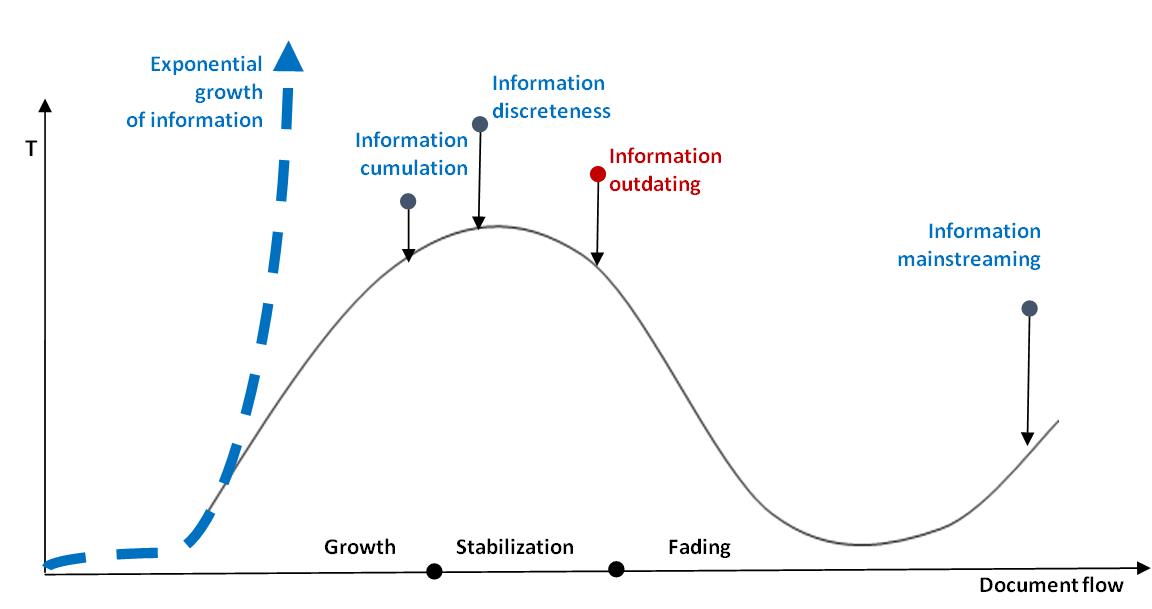Lesson 2. Information explosion and outdating
The 50s-60s of the 19th century were marked by exponential growth* of publications number termed “information explosion”. The amount of information increased due to its duplication, cumulation, transfer to newly published documents (articles, reviews, monographs), and discreteness (discontinuous nature) that required reading previous works to understand the meaning [1, 3, 4].
Search for information grew difficult, while the speed of reading and information comprehension by a man remained the same. In view of this, scholars tended to interpret “the objective and subjective factors hindering obtaining of necessary information and making it difficult to use documents as information sources” as “information barrier” [1].
Under the impact of new ways of generating and distributing information (Internet, in particular) document flow has multiplied. International Data Corporation (IDC) forecasts that worldwide digital data “will double every two years up to 2020, the ratio of useful information being merely 35% of the total generated information”, “and the amount of digital data will grow from 33 Zettabytes in 2018 to 175 zettabytes by 2025” [2, 5].
THUS, IT CAN BE INFERRED that increase in document flow is not always equal to increase in useful information.

Figure 1. Information flow in a subject category
CONSEQUENTLY, information outdating could take place. It should be noted that the outdating degree differs for different subject categories, for example, economical information becomes outdated faster than mathematical one, and articles become outdated faster than monographs.
Contextual outdating of information means “its increasing inconsistence with the needs of information consumers”, i.e. information looses such properties as relevance, authenticity, and originality [3, 4]. Outdating of a data storage device usually leads either to its destruction or to a restricted access.
* Exponential growth — is a specific way that a quantity may increase over time. It occurs when the instantaneous rate of change of a quantity is proportional to the quantity itself.
References:
1. Bibliotechnaya entsiclopediya / Ros. gos. b-ka. – Moscow : Pashkov dom Publ., 2007. –1300 p. – ISBN 5-7510-0290-3.
2. Lysak I. V. Vliyaniye informatsionno-lommunikatsionnykh tekhnologiy na osobennosti kognitivnykh protsessov / I. V. Lysak, D. P. Belov // Izvestiya YuFU. Tekhnicheskiye nauki. – 2013. – № 5 (142). – P. 256-264. – URL: https://cyberleninka.ru/article/n/vliyanie-informatsionno-kommunikatsionnyh-tehnologiy-na-osobennosti-kognitivnyh-protsessov (accessed: 18.09.2019).
3. Parshukova G. B. Metodika poiska professional'noi informatsii : ucheb.-metod. posobie dlya studentov vuzov / G. B. Parshukova. – Sankt-Peterburg : Professiya Publ., 2006. – 224 p. – ISBN 5-93913111-5.
4. Spravochnik bibliografa / nauch. red.: A. N. Vaneev, V. A. Minkina. – Izd. 3-e, pererab. i dop. – Sankt-Peterburg : Professiya Publ., 2006. – 592 p. – ISBN 5-93913-094-1.
5. Data Age 2025: The Digitization of the World – From Edge to Core : [otchet IDC] / by David Reinsel, John Gantz, John Rydning // Seagate : [сайт]. – URL: https://www.seagate.com/ru/ru/our-story/data-age-2025 (accessed: 18.09.2019).
Material prepared by Asya Kosenko, translated by Natalia Krasnogor



